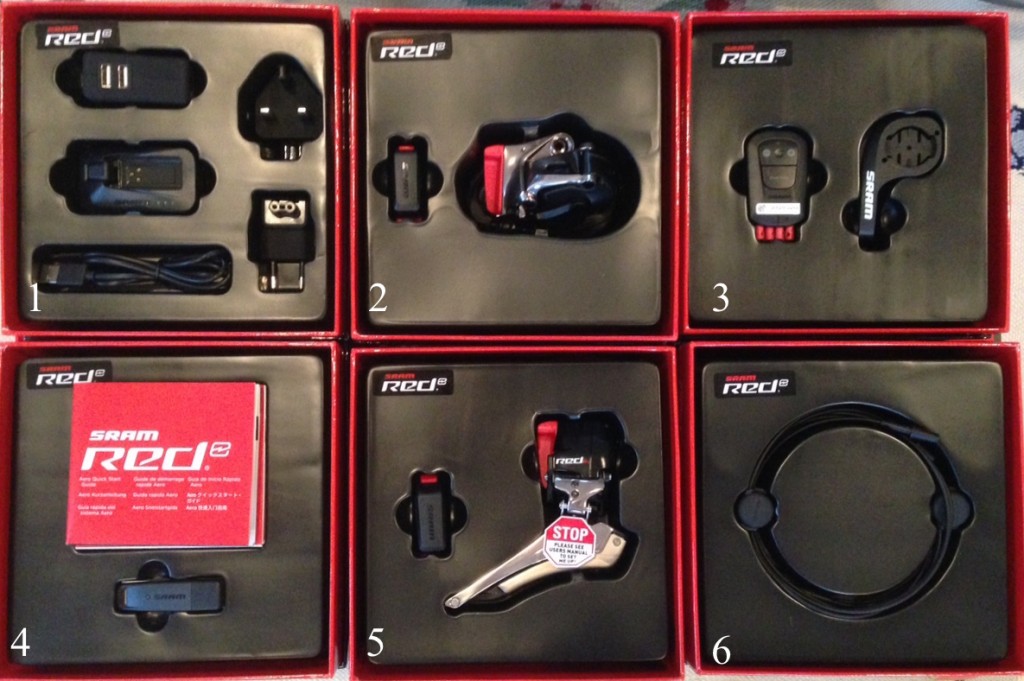
SRAM eTap Aero
I’ve been something of a retro-Luddite when it comes to gear-shifting technology. Party this is because I had several 9 speed race wheels, and I wanted to maintain interchangeability between bikes, and (I am embarrassed to admit) I found it difficult to figure out which parts I'd need to buy to set up a TT bike with Shimano Di2.
Enter SRAM’s new electronic gear system, eTap. For road bikes, this is a pretty straightforward system. Each brake lever has one gear change switch, and it operates the derailleurs wirelessly. Satellite shifting switches (the ‘’blips”) allow shifting from the top of the bars or clip-on aero bars. The right hand control shifts the rear mech up, the left control down. Pressing both controls at the same time changes the front mech either down or up, depending on which position the mech is currently in.
This spring, SRAM released the eTap Aero, intended for use on TT and triathlon bikes. I decided it was time to (a) get modern, and (b) get 11 speed. So I set my Wiggle profile to email me when the eTap aero was available. Ages later, I got an email saying it was in stock. I popped over to the Wiggle website to find four sets were available. I ordered one, along with an 11-speed Dura-Ace cassette and an 11-speed SRAM chain.
The box.
A few days later a vast box arrived at work. The post room called saying they thought a wheel had arrived for me! Inside was the cassette and chain, and an enormous and very heavy black and red box that just exudes quality.
[caption id="attachment_3638" align="alignnone" width="474"] This image shows the six smaller boxes (sourced from the Slowtwitch forum, and edited)[/caption]
Inside that were six smaller but equally robust boxes containing:
This image shows the six smaller boxes (sourced from the Slowtwitch forum, and edited)[/caption]
Inside that were six smaller but equally robust boxes containing:
 This image shows the six smaller boxes (sourced from the Slowtwitch forum, and edited)[/caption]
Inside that were six smaller but equally robust boxes containing:
This image shows the six smaller boxes (sourced from the Slowtwitch forum, and edited)[/caption]
Inside that were six smaller but equally robust boxes containing:
- USB battery charger. This comes with all sorts of wall socket adapters, and is for charging the derailleur batteries.
- The rear derailleur, with the battery detached. The red part covers and protects the attachment point of the battery: there's a complementary part to protect the battery - the front derailleur comes with identical parts.
- The blipbox. This is quite small, and has a Garmin style twist mount, there are several included. Neither mount with self adhesive pads matches the curvature of the top plate of my aerobar, so I used the normal Garmin mount held in place with stretchy bands (but see below).
- One USB stick for firmware updates. Just the USB stick. Nothing else other than a few scraps of paper.
- The front derailleur. This has the battery detached for transport, and a buch of weird little wedgy things, about which more later. Also, it has a horribly alarming sticker saying you MUST read installation instructions before using it. You need to retrieve said instructions from the SRAM website.
- Two sets of 'blips' (i.e. four blips in total). These are the switches that connect to the 'blipbox', which actually controls the derailleurs wirelessly. So, not much in that box.
Stay Informed
When you subscribe to the blog, we will send you an e-mail when there are new updates on the site so you wouldn't miss them.
Comments